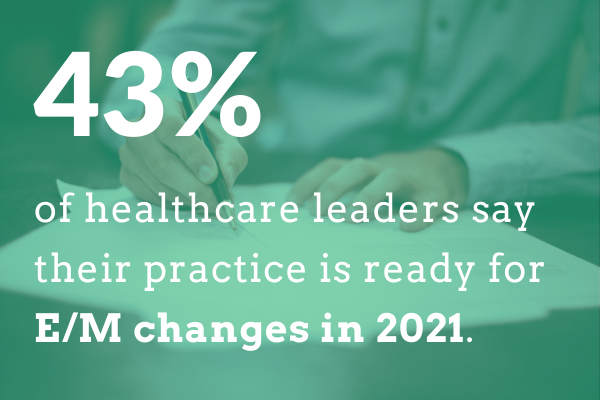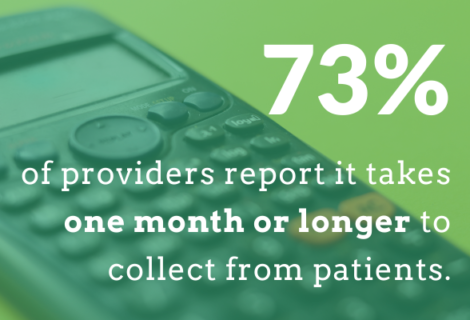New Year, New Policies: Understanding and Preparing for E/M Coding Changes in 2021
We’re entering yet another year of unprecedented change for value-based care — for providers, for patients, and for policy. Chief among these changes are updates to Evaluation and Management CPT codes 99202 through 99215, which came into effect on January 1, 2021.
As a follow-up to a 2019 Request for Information from the Centers of Medicare and Medicaid Services (CMS) — part of the ongoing Patients Over Paperwork initiative — the proposed changes are based on over 15,000 responses from healthcare providers nationwide. This feedback was in response to goals jointly-proposed by CMS and the American Medical Association (AMA):
- Simplify the documentation of history and physical exams for established patients.
- Clarify that documentation for both new and established patient office visits that have been entered in by ancillary staff or by the patient, needs to be reviewed and verified instead of “copy and paste.”
Whether the 2021 updates achieve these goals in a measurable way is yet to be seen, but clinicians participating in value-based care would be wise to prepare for what these changes mean for them in 2021. Otherwise, practice owners risk creating avoidable claim denials and driving up overhead costs.
Let’s take a closer look at what’s changed, why it matters, and how it will impact your practice this year (and beyond).
What’s Changing for Evaluation and Management in 2021
In a finding that will come as no surprise to clinicians, responses to the 2019 RFI highlighted that participants in value-based care “find themselves having to perform and document clinical activity that may be of only marginal relevance to the patient visit, but is required in order to receive the level of payment that their effort deserves,” according to CMS.
Changes this year will take aim at these inefficiencies in an effort to re-align Evaluation and Management documentation requirements with how doctors are actually evaluating, treating, and managing their patients. Here’s what you need to know about these updates:
- The change involves only office or other outpatient 99202 through 99215.
- 99201 was deleted due to insufficient use when billing for services.
- Clinicians only need to document the medically-appropriate history and physical exam per the nature of the patient’s presenting problems.
- When providing a patient service, the clinician must decide to level the service based on the medical decision making (MDM) process or the total time process.
Let’s take a closer look at #2…
“… the clinician must decide to level the service based on the medical decision-making (MDM) process or the total time process.”
If you haven’t done your homework on these changes, it’s here that you are likely to get tripped up — so let’s break down each approach.
Considerations for Medical Decision-Making (MDM)
Assuming you’ve already documented the appropriate history and physical exam for the patient, then the medical decision-making documentation must demonstrate the following:
The number and complexity of problems addressed.
This is defined as documentation supporting only the specific problems noted on that date of service, not the transfer of the patient’s problem list.
Risk and/or morbidity or mortality of patient management.
Per the AMA and with confirmation from CMS, there are now social issues and drug monitoring intensity that fall under the risk arena. The key to this type of documentation is to list the patient goals and whether or not those goals were achieved.
Amount and complexity of data to be reviewed and analyzed.
This is further defined by the updated MDM table in which “categories” need to be met by types. There will no longer be just a review of the statement of data.
So, what comprises a category or type that is analyzed? To answer this, let’s take a close look at the aforementioned categories:
Category 1: Tests, documents, orders, and review of prior external notes from each unique source or independent historian — each unique test, order, or document is counted to meet a threshold number.
Category 2: Independent interpretation of tests not reported separately. This is already billed for under another CPT code.
Category 3: Discussion of management or test interpretation with an external physician, or another qualified healthcare provider or appropriate source. This is not reported separately as it is already billed for under another CPT code.
For example, a provider can meet Category 1 if they document the ordering of a test and the reviewing of that same test — this equals 2 points under Category 1 of the MDM table. In contrast, a moderate MDM scenario may involve the order of three tests with review.
Considerations for Total Time (MDM)
Total time is defined as the time spent on the day of the encounter, which includes both face-to-face and non-face-to-face services. According to CMS, this includes:
- Preparing to see the patient (e.g., review of tests, review of previous medical record documentation)
- Obtaining and/or reviewing separately obtained history
- Performing a medically appropriate examination and/or evaluation
- Counseling and educating the patient/family/caregiver
- Ordering medications, tests, or procedures
- Referring and communicating with other health care professionals (when not separately reported)
- Documenting clinical information in the electronic or other health record
- Independently interpreting results (not separately reported) and communicating results to the patient/family/caregiver
- Care coordination (not separately reported)
Keep in mind that inclusions listed above are subject to changes as these guidelines are reviewed by CMS and insurance payors.
Clearly Document the Level of Care
If you choose to use total time for leveling an Evaluation and Management visit, you will need to be clear in your documentation about what is face-to-face service and what isn’t.
Time spent in your practice with your patient, for instance, would be considered face-to-face services. If you were to review diagnostic results after the patient has left your practice, however, this will need to be clearly documented as non-face-to-face. Both should be included in your calculation of total time.
Consider the Issues Documentation Requires
Take some time to do a review of the AMA CPT manual for changes in time values — you will need to understand the nuances here. For instance, let’s look at 99203. This is defined as an office or other outpatient visit for the evaluation and management of a new patient, and requires a medically appropriate history and/or examination with a low-level of medical decision-making.
When using time for code level selection, the requirement is 30-44 minutes of total time spent on the date of the encounter. For this reason, the visit documentation should be completed on the date of the encounter, not two days later.
Total Time: Friend or Foe?
Be mindful when using time to bill, as this will always need to be total time. If and when an audit occurs, there will inevitably be questions of how many patients were seen on that specific date of service, if those visits were all billed by time, when the clinician arrived at and left work, etc. If you aren’t cautious, this can easily lead to overbilling issues.
How to Prepare for Changes to 99202 through 99215
These changes to 99202 through 99215 all boil down to one takeaway: Medical necessity, not MDM or total time, will always be the overarching criterion for payment by CMD or third party payors like United Healthcare or BCBS. For this reason, practices involved in these changes and their implementation would be wise to have a clear understanding of how this impacts interactions with patients and decisions about their care.
The AMA recommends that physicians impacted by these changes take the following steps to prepare their teams and practices for 2021 Evaluation and Management updates:
- Dedicate time to training their team on process changes.
- Revise internal policy and procedures.
- Update the practice’s internal compliance plan.
- Track financials to determine if and how these changes impact practice revenue.
- Check with vendors and all supporting entities to ensure they’re prepared to comply with changes.
To quote the basic guideline of clinical documentation, “A long-standing tenet of clinical documentation is the importance of properly recording enough information so another physician can assume care if necessary, with a full understanding of the patient’s chief complaint, the treatment plan, and the outcome of either treatment or work-up.”
Remember that CMS’ fundamental goal was and is to, “ease the administrative burden on clinicians, reducing burnout and thus creating more time for patient care.” It’s changes like these that aim to do this specifically for value-based care providers.
Patients Over Paperwork, Then and Now
Centers for Medicare and Medicaid Services (CMS) first asked for feedback to support the Patients Over Paperwork initiative in 2017, their stated purpose for doing so was to update policies that were “outdated, duplicative, and overly burdensome.” The initiative was, according to CMS, an effort to, “increase quality of care, lower costs, improve program integrity and make the healthcare system more effective and accessible.”
If you didn’t read this letter much less respond to it, don’t worry — you’re among the majority. CMS data shows that the initial Request for Information process received only 3,000 responses, and just 2,000 healthcare stakeholders participated in listening sessions. That feedback did cover a considerable breadth of issues — 1,146 distinct burden topics, according to CMS — but the overall response from the clinical community was, in a word, underwhelming.
That said, this modest response doesn’t represent how strongly the clinical community actually feels about the impact these “burdensome processes” have on their patients. According to a 2013 poll, 92% of residents reported that clinical documentation obligations are excessive, and 73% reported compromises in patient care by these requirements.
We know this underwhelming response to the 2017 RFI speaks more to the clinical community’s understandable hesitance to expect meaningful changes following initiatives like this one. Even after changes related to the initial Patients Over Paperwork RFI were rolled out in 2019, multiple medical groups expressed concern that, “there remain too many rules for providers participating in value-based care,” and say that the program still hasn’t delivered the ease of administrative burden that was promised at the initiative’s outset.
What 2021 Means for ‘Patients Over Paperwork’
Changes this year, however, could be a milestone moment for the initiative. Because these changes impact Evaluation and Management codes, they have a greater impact on how clinicians document time spent face-to-face with the patient. Consequently, these changes could have a greater impact on the overall patient experience than did the 2019 proposed rule for the Physician Fee Schedule — especially as CMS gears up to request feedback on changes to all remaining Evaluation and Management CBT codes later this year.
Ultimately, time will tell if these proposed changes deliver a more streamlined process for clinicians to deliver quality value-based care to the patients that need it. Your best bet is to continue working closely with your revenue cycle management partner in order to navigate ongoing updates from CMS and what it means for you, your practice, and your patients.
Need assistance understanding how these changes impact your practice? Learn more about how Zenith Healthcare Solutions can help you streamline medical billing and revenue cycle management in your practice.



Recent Comments